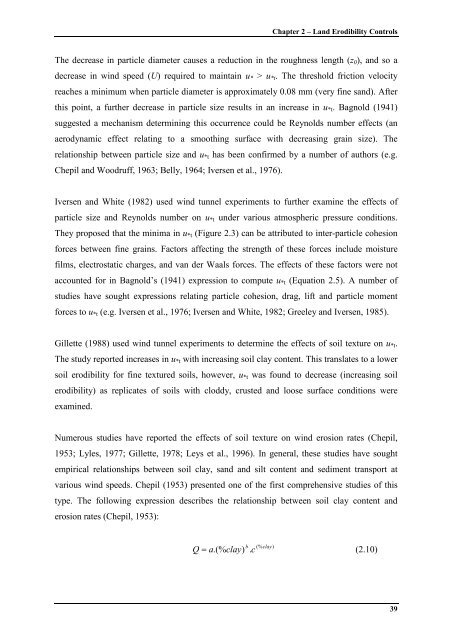Wind Erosion in Western Queensland Australia
Modelling Land Susceptibility to Wind Erosion in Western ... - Ninti One
Modelling Land Susceptibility to Wind Erosion in Western ... - Ninti One
You also want an ePaper? Increase the reach of your titles
YUMPU automatically turns print PDFs into web optimized ePapers that Google loves.
Chapter 2 – Land Erodibility ControlsThe decrease <strong>in</strong> particle diameter causes a reduction <strong>in</strong> the roughness length (z 0 ), and so adecrease <strong>in</strong> w<strong>in</strong>d speed (U) required to ma<strong>in</strong>ta<strong>in</strong> u * > u *t . The threshold friction velocityreaches a m<strong>in</strong>imum when particle diameter is approximately 0.08 mm (very f<strong>in</strong>e sand). Afterthis po<strong>in</strong>t, a further decrease <strong>in</strong> particle size results <strong>in</strong> an <strong>in</strong>crease <strong>in</strong> u *t . Bagnold (1941)suggested a mechanism determ<strong>in</strong><strong>in</strong>g this occurrence could be Reynolds number effects (anaerodynamic effect relat<strong>in</strong>g to a smooth<strong>in</strong>g surface with decreas<strong>in</strong>g gra<strong>in</strong> size). Therelationship between particle size and u *t has been confirmed by a number of authors (e.g.Chepil and Woodruff, 1963; Belly, 1964; Iversen et al., 1976).Iversen and White (1982) used w<strong>in</strong>d tunnel experiments to further exam<strong>in</strong>e the effects ofparticle size and Reynolds number on u *t under various atmospheric pressure conditions.They proposed that the m<strong>in</strong>ima <strong>in</strong> u *t (Figure 2.3) can be attributed to <strong>in</strong>ter-particle cohesionforces between f<strong>in</strong>e gra<strong>in</strong>s. Factors affect<strong>in</strong>g the strength of these forces <strong>in</strong>clude moisturefilms, electrostatic charges, and van der Waals forces. The effects of these factors were notaccounted for <strong>in</strong> Bagnold’s (1941) expression to compute u *t (Equation 2.5). A number ofstudies have sought expressions relat<strong>in</strong>g particle cohesion, drag, lift and particle momentforces to u *t (e.g. Iversen et al., 1976; Iversen and White, 1982; Greeley and Iversen, 1985).Gillette (1988) used w<strong>in</strong>d tunnel experiments to determ<strong>in</strong>e the effects of soil texture on u *t .The study reported <strong>in</strong>creases <strong>in</strong> u *t with <strong>in</strong>creas<strong>in</strong>g soil clay content. This translates to a lowersoil erodibility for f<strong>in</strong>e textured soils, however, u *t was found to decrease (<strong>in</strong>creas<strong>in</strong>g soilerodibility) as replicates of soils with cloddy, crusted and loose surface conditions wereexam<strong>in</strong>ed.Numerous studies have reported the effects of soil texture on w<strong>in</strong>d erosion rates (Chepil,1953; Lyles, 1977; Gillette, 1978; Leys et al., 1996). In general, these studies have soughtempirical relationships between soil clay, sand and silt content and sediment transport atvarious w<strong>in</strong>d speeds. Chepil (1953) presented one of the first comprehensive studies of thistype. The follow<strong>in</strong>g expression describes the relationship between soil clay content anderosion rates (Chepil, 1953):(% clay)Q = a.(%clay)b . c(2.10)39
















